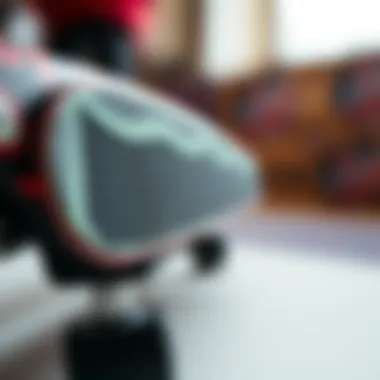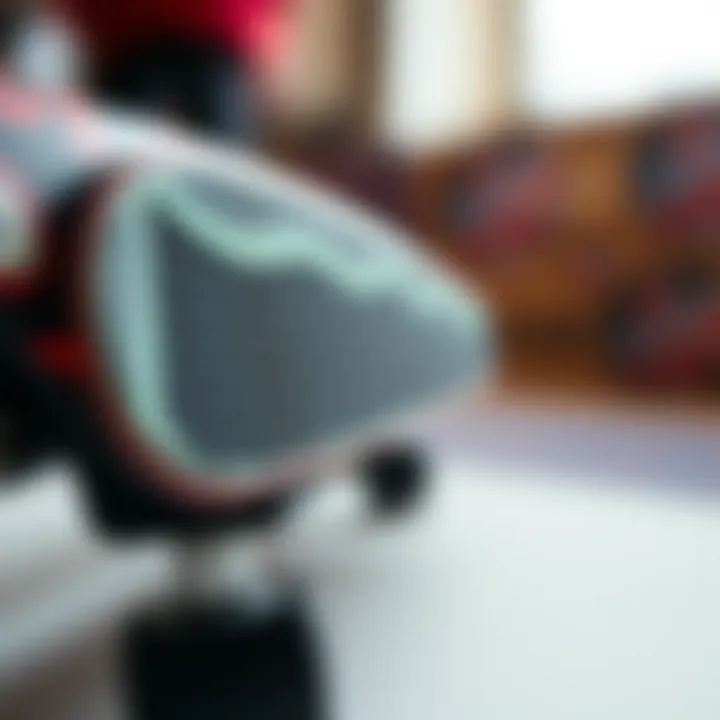Exploring the Significance of the 31 x 8 Skateboard


Intro
Skateboarding is not purely about tricks or the roar of wheels on pavement. It's a culture deeply embedded in the pursuit of thrill, expression, and skill development. Among the diverse range of skateboards available, the 31 x 8 skateboard has gained prominence due to its versatile build and performance capabilities. This size strikes a unique balance, appealing to both beginners and seasoned riders. Understanding its components, functionality, and wider significance can equip skaters with insights that can elevate their experience.
The sport has seen a series of transformations, but the fundamentals remain—finding the right board is crucial. The 31 x 8 size often serves as a stepping stone in a rider's journey, and the nuances of its design lend themselves to various skating styles.
Techniques and Tips
Skill Development
Mastering the 31 x 8 skateboard goes beyond just balancing. Skill development in skateboarding is a gradual process that hinges on understanding the board's dynamics. Riders should focus on body positioning, weight distribution, and foot placement. Begin by practicing the ollie technique, which forms the foundational trick for many advanced maneuvers. This skill not only assists in jump heights but also enhances a rider's overall stability on the board.
Practical Techniques
Using this skateboard effectively requires specific techniques tailored to its dimensions. Here are several practical techniques to practice:
- Foot Positioning: Ensure your back foot is on the tail while your front foot hovers above the middle. This balance allows for easier turns and tricks.
- Pushing Off: Use the front foot to gain momentum. When pushed smoothly, it creates a more seamless riding experience.
- Turning: Shift your weight in the intended direction. Lean into turns rather than forcing the board; it keeps the ride stable.
With consistent practice, you'd notice a significant improvement in your control and confidence.
Common Mistakes to Avoid
Navigating the world of skateboarding entails a learning curve, and avoiding common pitfalls can enhance progress:
- Riding with Tension: Skaters often hold too much tension in their bodies. Relaxing your muscles allows for smoother movements and better flow.
- Neglecting Safety Gear: While not immediately relatable to riding skill, ignoring safety gear can have severe consequences. A simple helmet can be a life-saver.
- Overcoming Fear: It's natural to hesitate before attempting tricks. However, letting fear dictate your actions might hinder your skills. Trust in the equipment.
"Skateboarding is an art, and like any art, it requires patience and practice to master."
Gear and Equipment
Essential Gear for Beginners
For those just stepping into the skateboarding realm, it’s vital to invest in appropriate gear. Here’s an essential list to get any rookie started on the right foot with their 31 x 8 skateboard:
- Helmet: Always wear one. Protecting your head is paramount.
- Pads: Knee and elbow pads help in avoiding injuries during falls.
- Skate shoes: Ensure they have good grip and flexibility for better control while riding.
Latest Innovations and Trends
Innovation in skateboarding gear doesn’t stand still. Recent trends focus on enhancing performance and safety. Features like shock absorption technology in wheels or customizable grip tape designs elevate the board to new heights. Companies like Element and Baker are known to roll out exciting upgrades regularly.
Reviews and Comparisons
When considering which 31 x 8 skateboard to purchase, tap into online reviews and community discussions. Websites like Reddit often host threads discussing various models, offering a variety of perspectives. Furthermore, YouTube reviews can personalize the decision-making process, showcasing real-world performance.
Safety Measures
Essential Safety Gear
Safety gear is not optional. It's a necessity for preserving your skateboarding journey. Some critical gear includes:
- Protective Gloves: Ideal for preventing scrapes during falls.
- Impact Shorts: These won't make you any less stylish while riding. They cushion your tailbone and hips in case of a bad fall.
Best Practices for Safe Participation
To maintain safety while skateboarding, keeping a few practices in mind is essential:
- Choose Low Traffic Areas: Practicing in quieter locations ensures fewer distractions and potential hazards.
- Know Your Limits: Start with basic tricks and techniques before advancing. It’s better to master the small stuff first.
Injury Prevention and Management
Injuries are an unfortunate part of skating, yet many can be prevented with proper techniques and safety measures. Should an injury occur, ice the affected areas and consult a healthcare professional for severe cases. Developing a solid understanding of body mechanics helps recognize how to avoid specific injuries.
Spotlights on Extreme Sports
Featured Sport of the Month
This month, we highlight street skating. It encapsulates not only the technical skill involved but also the mindset of utilizing urban landscapes as your playground. Street skating emphasizes creativity and adapting to surroundings, which makes it a thrilling pursuit.
Profiles of Prominent Athletes


Understanding the sport is incomplete without acknowledging the athletes who push its boundaries. Notable figures such as Tony Hawk, known for his tricks and signature style, continue to inspire countless skateboarders across the globe. With their dedication and uniqueness, they continually shape the culture and attract newcomers to skateboarding.
Through examining the intricacies of the 31 x 8 skateboard, individuals can deepen their appreciation for skateboarding as both a sport and a lifelong journey. Whether you're just starting or looking to refine skills, the 31 x 8 offers something for everyone.
Prelims to Skateboard Dimensions
Skateboarding is not just a hobby; it's a way of life for many, and choosing the right equipment, particularly the skateboard size, plays a fundamental role in shaping that experience. Understanding skateboard dimensions—basically, the measurements that define different boards—can drastically influence how a skater tricks, maneuvers, and ultimately enjoys their ride. This article delves into the specifics of the 31 x 8 skateboard, a popular choice among both newbies and seasoned riders.
The significance of skateboard size transcends mere numbers. It impacts everything from stability to performance, making it crucial for skateboarders to narrow down their options based on not just preference but also the intended riding style. Whether one is skimming along the sidewalk or launching off ramps at a skate park, a board that conforms to their body and skill set can make all the difference. In essence, knowing how dimensions interplay can lead to better choices and an enriched skateboarding journey.
Defining Skateboard Sizes
When we talk about skateboard sizes, we generally reference two key figures: the length and width. The length of a skateboard typically ranges from about 28 inches to 33 inches, while the width commonly spans from 7.5 inches to nearly 9 inches. Skateboards are usually categorized based on these measurements, and you might hear terms like "short board," "mid deck," or "long board" floating around.
The 31 x 8 measurement, specifically, indicates a board that is 31 inches long and 8 inches wide. This size is particularly versatile, offering a solid platform for tricks while maintaining a manageable profile for transportation and storage. By having standardized dimensions, manufacturers can cater to a variety of rider styles, ensuring that there’s a suitable board for diverse skating experiences.
The Relevance of Width and Length
The relationship between a skateboard's width and length is not merely mathematical; it influences how skaters interact with their environment. A wider board, such as the 31 x 8 setup, generally provides better stability. This is particularly advantageous for beginners who may still be gaining their balance. Consider this: in high-impact situations, like landing a trick, a wider board helps distribute weight more evenly, reducing the chance of wiping out.
Conversely, lengthier boards afford skaters a greater opportunity for speed and smoother rides over rough terrain. The extra inches allow for more room when executing technical moves or alternate foot placements. Thus, a 31-inch length paired with an 8-inch width creates a well-rounded option that caters to most intermediate to advanced riders too who blend style with technical skills.
In summary, grasping skateboard dimensions, such as the 31 x 8 specifications, opens a treasure chest of insights that can vastly improve the skating experience. Choosing the right dimensions is about more than preferences; it's foundational to optimizing performance and achieving personal bests within the thrilling skateboarding world.
The x Skateboard: Key Features
The 31 x 8 skateboard holds a special place in the heart of the skateboarding community. It embodies a balance of size, stability, and flexibility that suits a wide range of skating styles and skill levels. Understanding its key features provides insight into why it is often the go-to choice for both novices and seasoned riders. The dimensions of this board mean it offers good surface area for tricks, while maintaining a manageable weight that is essential for both control and performance.
Understanding the Measurements
When we talk about a 31 x 8 skateboard, we're discussing its length and width. The 31 inches long provides ample space for both balance and foot positioning, which is particularly beneficial for learning new tricks or fine-tuning maneuvers. The 8-inch width strikes a commendable balance, providing enough surface for foot placement, while allowing for smoother transitions when performing tricks. Most skaters would agree that a wider board generally allows for greater stability, especially during the landings of tricks.
Also, this size is versatile. It can cater to street skating, park skating, or even cruising. A skateboard of this size can handle a variety of terrains without compromising performance. Many riders find that they can easily shift their stance and manipulate the board in various environments, from skate parks to urban landscapes.
Material Composition and Durability
The durability of a skateboard is paramount for any serious rider. A 31 x 8 skateboard typically consists of layers of maple wood or other composite materials designed to withstand the wear and tear of trick-heavy riding. This multi-layer construction provides not only strength, but also a certain amount of flexibility, which is crucial when absorbing impacts from jumps or falls.
Aside from wood, some boards are now made with modern materials like bamboo or fiberglass. These options can provide unique benefits. For instance, bamboo boards tend to be lighter but still can pack a punch in terms of durability, making them a popular choice among trick skaters.
If you're considering a 31 x 8 skateboard, look closely at material specs. A board with a solid construction will often result in a better skateboarding experience. You want something that withstands the rigors of daily use without warping or cracking. Choosing the right material contributes significantly to prolonged enjoyment of your board, ensuring that even with frequent use, it remains reliable.
"The right skateboard isn't just a piece of equipment; it's the foundation of your skating journey."
In summary, knowing the key features of a 31 x 8 skateboard, from its measurements to material composition, illuminates its role as a versatile and durable tool for skating enthusiasts. It's designed thoughtfully, ensuring it meets a range of rider needs and expectations, making it a worthwhile investment for anyone serious about mastering tricks or just enjoying the ride.
Performance Analysis: Handling and Stability
When it comes to skateboarding, understanding how a board performs can make or break your experience. The handling and stability of the skateboard are pivotal, especially for those wishing to push the limits of their skills. With the 31 x 8 skateboard, balancing these aspects allows skaters to better navigate different terrains and achieve various tricks, ultimately enhancing their overall riding experience.
An essential dimension in performance is the width and length. This specific skateboard size provides optimal balance, encouraging stability during ride, and a wider base contributes to less wobbling. This is particularly beneficial when tackling turns or performing tricks where precision is key. A board that feels stable underneath your feet gives confidence, which is important when you’re trying to land that tricky maneuver or navigating a crowded park.
Impact on Maneuverability
Maneuverability refers to how easily a skateboard can be turned or steered. The 31 x 8 skateboard straddles a unique line, offering enough surface area for stability while also allowing for agile movements. This is crucial for a skater wanting to navigate sharp corners or dodge obstacles in a skate park.
- Wider Boards for Stability: The 8-inch width offers a solid platform. When you lean into a turn, the board's wider stance supports your weight without compromising balance.
- Length Matters: The 31-inch length provides just enough space for foot placement, making it easy to shift your weight and adjust your stance quickly. This ability to reposition your feet assists in sharper turns.
- Foot Placement: Riders who favor tricks often find that the design translates into ease of foot positioning, offering a comfortable spot to land after a jump or flip.
These elements come together to create a board that responds well when called upon, whether you're hopping off curbs or carving deep turns. The distinctive combination sets the stage for a balance between speed and control, making it ideal for various styles of skating.
Riding Styles Suited to x Skateboards
With its distinctive characteristics, the 31 x 8 skateboard caters to a range of riding styles, making it a versatile tool for any skater.
- Street Skating: Street skaters appreciate the balance offered by the 31 x 8 board for flipping tricks and navigating urban environments, where tight corners and obstacles are commonplace.
- Park Riding: The stability when hitting ramps and bowls allows for smooth transitions, making it easier to pull off complex tricks. The board's design aids those who want to kick up the tricks with confidence.
- Cruising: For those more inclined towards laid-back sessions around town, this board serves well with its roomy deck, ensuring comfort during longer rides.
- Vert Skating: Experienced riders often favor this size for vert ramps due to its ability to maintain control and stability at higher speeds.
Comparative Assessment: Small vs. Wide Skateboards
When delving into the world of skateboards, an essential discussion emerges surrounding the comparison of small versus wide boards. The choice between these two dimensions impacts not just the aesthetic appeal of the skateboard, but significantly influences all aspects of the riding experience. For thrill-seekers and extreme sports enthusiasts, understanding the practical implications of selecting a wider or smaller skateboard serves a dual purpose—maximizing performance while matching individual skill levels and personal preferences.


Wide boards, such as the 31 x 8 variant, provide specific benefits that cater to both novice riders and seasoned pros, drawing attention to why riders might prefer one size over another.
Advantages of a Wider Board
- Stability and Balance: A wider board increases the surface area for foot placement, offering a more balanced ride. Skaters tend to feel grounded and secure, especially when trying tricks that require greater maneuverability or stability. The wider stance can lead to more confident landings and steady cruising, making them a go-to option for those learning the ropes.
- Trick Variety: With ample space on the deck, executing kicks, flips, and more dynamic tricks becomes easier for skaters. The broader landing zone allows for more leniency in foot positioning, potentially reducing wipeouts when mastering new tricks. Riders can experiment with various techniques without the added stress of balancing on a narrower deck.
- Comfort during Rides: Larger boards usually have more foot space, providing comfort for a range of shoe sizes. Eventually, comfort translates to longer riding sessions, making them suitable for those thrilling skateboarding adventures.
- Better for Transition: Skateboarders who enjoy parks with ramps and bowls can benefit greatly from a wider board. The expanded surface assists with control during transitions, enabling better grip on inclines and declines, hence enhancing the overall experience.
"The width of your skateboard can be the difference between mastering that trick or taking a tumble. It’s not just about flair; it’s about consistency."
Disadvantages and Limitations
Despite their advantages, wider skateboards come with considerations that may not suit every rider:
- Weight and Size: Wider boards generally weigh more than their narrower counterparts. For some skaters, especially those who favor street skating or long-distance pushes, the extra bulk can be a hindrance. The larger board may require more effort to maneuver at speed, which could deter those who thrive on quick transitions.
- Difficulty in Tricks: Interestingly, while wide boards offer more landing surface, they might complicate certain technical tricks that require foot precision. Riders working through pops or grinds may find themselves struggling with the additional width, leading to imprecise executions.
- Space Requirements: A wider board will demand more real estate for tricks and during storage. In crowded skating parks or small areas, it can become cumbersome and might even limit the skater's ability to navigate tight spaces.
- Culture and Image: For some riders, there’s a cultural aspect tied to what boards are preferred within their skate communities. Wider boards have often been associated with specific styles that may not resonate with every skater. Selecting a board that aligns with personal expression is as crucial as performance features.
In summary, choosing between a small versus wide skateboard is more than just a preference; it is a comprehensive decision that encases stability, comfort, and cultural expression against weight and maneuverability. Each rider’s decision might vary based on their style, intentions, and environment, making it imperative to reflect on personal needs. Ultimately, understanding these elements lays the groundwork for a more gratifying skateboarding experience.
Suitability for Different Riders
Choosing the right skateboard is not a one-size-fits-all affair. Different riders bring unique styles, skill levels, and preferences to the table, and understanding what a 31 x 8 skateboard offers can be crucial for their performance and enjoyment. This section will delve into the suitability of this particular size for various types of skateboarders, providing insights that can help both novices and seasoned pros make informed decisions.
Novice Skateboarders
For those just starting their journey on a skateboard, the 31 x 8 size presents a balanced platform that strikes a blend between stability and agility. Newbies benefit from the wider surface area, which allows for an easier stance and enhanced footing. It's akin to learning to ride a bicycle with training wheels—having that little extra support can make all the difference.
- Stability: The width offers significant stability, reducing the likelihood of slips while practicing balance and basic tricks.
- Learning Curve: It serves as a forgiving space for trial and error, whether one is doing ollies or learning to push off.
- Versatility: As beginners progress, they can easily transition into more advanced riding styles without needing to switch boards.
This platform subtly encourages confidence, making the challenging early days of skating just a tad easier.
Experienced Skaters
For those who have honed their skills over time, the 31 x 8 skateboard provides an adequate challenge while allowing riders to maintain control over their maneuvers. Experienced skaters appreciate the board's balance in executing tricks and transitioning between different styles of skating—be it street, park, or vert.
- Trick Performance: While some may argue it's not as nimble as narrower boards for intricate tricks, it compensates by allowing for larger stances and more stability in landings, which may lead to higher confidence in attempting difficult moves.
- Durability: These boards often come with reinforced materials designed to withstand the rigors of street skating, making them a robust option for frequent riders.
- Adaptability: More skilled riders can use the 31 x 8 board effectively across various skate environments, further extending its usefulness.
For seasoned skaters, this board can become a trusty companion that counters their adventurous spirit while accommodating various tricks and styles.
Age and Size Considerations
When selecting a skateboard, age and size play critical roles in determining its suitability. The 31 x 8 board caters well to a diverse demographic that includes not just youth but also older riders seeking a reliable board that doesn’t compromise too much on performance.
- Child and Youth Riders: This dimension supports young skaters, accommodating their growth and offering room for comfort as they develop their skills in skating.
- Adult Riders: Adults, especially those returning to the sport after years, will find that the board's design can handle slightly heavier weights while still offering a sense of ease when maneuvering.
- Weight Variance: This board is structurally designed to support various weight classes, ensuring safety and performance for skaters of all sizes.
In summary, those looking to find a skateboard that caters to various capabilities and sizes would do well to consider the 31 x 8 skateboard. It serves not just a single category of users; it’s an all-encompassing tool for skateboarding enthusiasts of all shapes and forms.
This breadth of usability is one of the compelling reasons behind the 31 x 8 skateboard's sustained popularity in the skating community.
Cultural Influence of Skateboard Sizes
The cultural influence of skateboard sizes transcends mere dimensions. It reflects the evolution of skateboarding as an activity that’s deeply rooted in self-expression, identity, and community. As skateboards have developed over the years, they’ve become symbols of various subcultures, reflecting broader trends in lifestyle, music, and even fashion. Understanding the interplay between skateboard sizes, particularly the 31 x 8 skateboard, and cultural dynamics can shed light on how skaters connect with their environment and each other.
Evolution of Skateboard Shapes
Skateboarding’s history is rich with twists and turns, much like the tricks skaters perform. The evolution of skateboard shapes plays a key role in determining rider styles and preferences. In the early days, boards were primarily rectangular and narrow, reflecting the utilitarian needs of skaters. As time went on, particularly in the 1980s and 1990s, shapes began to diversify, catering to different riding styles—from cruising down streets to executing complex tricks in skate parks.
- Longboards, for instance, emerged for those seeking a smooth ride, while street skateboards became narrower for better flip tricks and technical maneuvers.
- The 31 x 8 skateboard strikes a balance, combining sufficient width for stability and length for versatility, supporting skaters of all levels.
- Shapes also began incorporating concave designs, allowing for better control while doing tricks like kickflips and grinds.
The changes in shapes reflect not just functional needs but a cultural shift among skaters who began to see skateboarding as more than a sport; it became a lifestyle and a means of artistic expression. Changes in skateboard aesthetics often coincide with movements in music, art, and fashion, showcasing the interconnectedness of these cultural elements.
Trends in Skateboarding Community
Skateboarding culture is a living, breathing entity that evolves in response to societal changes. Recently, there has been a surge in interest in diversity within skateboarding, with initiatives aimed at making the sport accessible to everyone, regardless of age or background. The 31 x 8 skateboard has gained popularity in this wave due to its accommodating dimensions which serve a wider audience.
- Inclusivity in Design: Companies are now releasing limited edition boards that embrace different shapes, graphics, and colors. This has not only enhanced visual appeal but also fostered a sense of belonging among various groups in the skating community.
- Environmental Awareness: There's also a growing emphasis on sustainable materials in skateboard manufacturing, as environmental concerns become more pressing. This shift aligns with a broader cultural response among younger skaters who prioritize eco-conscious practices.
- Online Communities: Platforms like Reddit and various skateboarding forums play a huge role in shaping trends. They facilitate knowledge sharing and bridge the gap between novice and experienced skaters, making it easy for individuals to find their niche or influencers who resonate with them.
The way skateboard sizes, especially the 31 x 8 model, are embraced in these trends signifies not just a preference for design but a deeper connection among skaters. The discussions around these sizes often mirror trends in music and art, indicating that skateboarding is not just a hobby but a cultural phenomenon that unites many under a common banner.
Maintenance and Care for Your Skateboard
Caring for your skateboard isn't merely about keeping it looking sharp; it's about preserving the functionality and safety of this essential ride. Just like you wouldn’t drive a car that was falling apart, hitting the pavement with a poorly maintained board can lead to unfortunate accidents or even injuries. Skaters, both seasoned and newcomers, should take heed of the importance of maintenance and care for their skateboards, particularly those enjoying the versatile 31 x 8 size.


Cleaning and Upkeep
Keeping your skateboard clean is simpler than keeping a cat off the furniture, but it does require some commitment. Dirt, grime, and gunk can accumulate on both the deck and the trucks over time. Here are some easy steps to ensure your board remains in tip-top shape:
- Wipe Down the Deck: Use a damp cloth to clean the surface. Avoid soaking the board; the layers of wood and adhesive can be compromised if they get too wet. For sticky spots or stains, a mild soap can come in handy.
- Inspect the Grip Tape: The grip tape can get fuzzy or worn. A gentle scrub with a stiff brush can help refresh it. This grip is your best friend—it keeps your feet planted where they should be, so don’t neglect it.
- Check the Trucks: Dust can settle in the crevices of the trucks. Make it a point to clean these with a dry cloth. Keeping the trucks clean helps with smoother turns and a more enjoyable ride.
- Periodic Deep Cleaning: Every once in a while, give your board a thorough once-over. Detach the wheels and clean them with soap and water. Rust on the bearings? Well, it might be time to look into replacement bearings if that’s the case.
Ultimately, investing time in maintenance can prolong the life of your 31 x 8 skateboard, giving you peace of mind while catching some sick air.
Replacement and Repair Tips
No skater can escape the inevitability of replacing parts or conducting repairs. Wear and tear is a part of the game, and knowing when and how to replace or repair can save you money and a whole lot of frustration in the long run. Here’s a rundown on what you should look out for and how to handle repairs:
- Recognizing Wear: Your wheels should roll smoothly. If you hear a grinding sound or feel resistance while skating, it’s time to check the wheels and bearings.
- Changing Wheels: When replacing wheels, consider the size. The 31 x 8 boards generally use larger wheels for stability. Picking the right durometer (hardness) is critical for the ride experience.
- Fixing the Grip Tape: If the grip tape is peeling or has bald spots, it’s wise to replace it. A well-gripped board is a stable board. Line up a fresh grip tape with the board’s edges, apply, and trim excess.
- Trucks Maintenance: Loose trucks can cause a wobbly ride. Tighten them as needed, but avoid an over-tightened setup to keep your board flexible.
- When to Replace Bearings: If your wheels don’t spin freely even after cleaning, replace the bearings. Quality bearings can be a game-changer in how your board rides.
In the end, efficient replacement and repair strategies will ensure that your 31 x 8 skateboard remains reliable and ready for new tricks. Maintain it well, and it might just reward you with countless rides and adventures.
Safety Considerations for Skaters
Safety is not just a buzzword in skateboarding; it’s a vital part of the sport that can’t be underestimated. Riders who hit the pavement without proper safety measures put themselves at an increased risk of severe injury. Therefore, understanding safety considerations can mean the difference between a joyful ride or an unfortunate trip to the hospital.
Essential Protective Gear
Before anyone even thinks about stepping on a skateboard, it’s essential to gear up. The right protective equipment not only enhances safety but can also boost a surfer’s confidence. Some key items include:
- Helmet: A must-have. Helmets protect the skull and can significantly reduce the risk of brain injuries during falls. It's like having a shield around your head.
- Wrist Guards: These protect the wrists—often the first part of the body to break a fall. Nailing tricks is fab, but it's not worth a wrist sprain.
- Knee Pads and Elbow Pads: These pads protect the joints and absorb impacts. They might seem bulky, but their importance cannot be overstated.
- Proper Footwear: The right skate shoes offer necessary grip and support, making it easier to perform tricks without slipping or losing control. You wouldn't want to skate in flip-flops!
In choosing protective gear, it's worth noting the fit and comfort. All of these items should fit snugly but not too tight and should allow for all the movement needed while skating. Additionally, the aesthetic should match one’s style—after all, looking good while cruising is part of the game!
Safety Practices While Riding
Skating skills are just one part of the equation. Safe riding practices can set apart experienced riders from novices. Here are some key practices that are essential for every skater:
- Know Your Limits: Attempting tricks that are beyond one’s skill level can result in catastrophic accidents. Understanding individual limits should be part of every skater’s mindset.
- Stay Aware of Surroundings: As a rider, it’s critical to be aware of obstacles, other riders, pedestrians, and even vehicles while skating. Keeping an eye on what’s around you helps in making split-second decisions.
- Practice in Safe Areas: Beginners should start in less crowded spaces or skate parks designed for learning. This minimizes the risks of colliding with others.
- Warm-Up Before Riding: Just like any sport, skating isn’t without its strains. A proper warm-up can help prevent injuries. Stretching those legs before launching into a trick is a smart move.
Selecting the Right x Skateboard
Choosing the appropriate 31 x 8 skateboard is more than just a matter of style; it significantly influences a rider's performance and overall experience on the board. This section aims to guide both newcomers and seasoned skaters through the intricacies of making an informed choice. The 31 x 8 skateboard stands out among other sizes, offering a balance between stability and maneuverability that appeals to various riding styles.
When considering a skateboard, understanding one's specific needs, skill level, and riding ambitions is paramount. Will the skateboard be used for cruising around the neighborhood, or is it meant for performing tricks at the local skate park? Factors such as these can greatly inform the selection process and enhance riding enjoyment.
Factors to Consider When Choosing
Selecting the right board can feel overwhelming, especially when faced with different brands and models. Here are some key factors to keep in mind:
- Material Composition: The deck material plays a crucial role in durability and weight. Common options include maple wood, carbon fiber, or plastic. Maple is often favored for its balance between strength and flexibility.
- Shape and Concave: The shape of the skateboard, including the concave, affects both stability and trick performance. A deeper concave provides better foot grip, which aids in trick execution.
- Wheel Hardness and Diameter: Softer wheels absorb more shock, making them ideal for rough surfaces, while harder wheels are better for smooth surfaces and tricks. The diameter can affect how fast you go and how well the board turns.
- Riding Style: Whether you're into street skating, vert, or cruising influences your choice. Each style may require different deck characteristics.
- Aesthetics: While performance is essential, the look of the skateboard can be a deciding factor too. Different designs can express personal style, making it a key consideration for many riders.
By taking these factors into account, skaters can pinpoint a board that not only fits their body size but also aligns with their skating aspirations.
Recommendations for Buyers
For those ready to hit the shops or browse online, here are some recommendations to aid your decision:
- Look for brands with a solid reputation in the skate community, such as Element, Birdhouse, or Santa Cruz. Their models tend to emphasize quality and performance.
- Don’t shy away from seeking out user reviews and recommendations on forums like Reddit or skateboarding-specific sites. Engaging with fellow skaters can provide valuable insight that influences your decision.
- Consider purchasing from local skate shops, which often offer personalized advice and a chance to feel the board in person before buying.
- If possible, attend skateboarding events or expos. These venues often give you hands-on exposure to various brands and styles, while also allowing you to connect with experienced skaters who can share first-hand experiences.
In the end, the right skateboard isn't just about numbers or trends; it's about finding a device that resonates with your personal skating journey. Arm yourself with knowledge and consider your own unique style as you embark on this crucial selection process.
Closure: Embracing the x Skateboard
The 31 x 8 skateboard stands as a significant choice for many riders, encapsulating balance between comfort and performance. Taking into account its width and length, this size appeals not just to the beginners who are wobbling their way onto the skate scene, but also to seasoned skaters seeking control and agility.
One major benefit is the stability that a board of this dimension provides. The wider surface area allows for a bit more room to place feet. This can lend itself to better overall foot placement, making tricks and maneuvers smoother. Putting it simply, stability can give skaters more confidence as they roll into their first kickflip or navigate through complex skate parks.
Moreover, the 31 x 8 skateboard embodies versatility suited for various riding styles. Whether you're tearing up the streets or grinding the rails, this size allows for a seamless transition from one style to another. Skateboards of this size cater effectively to street skating as well as casual cruising, bridging gap between performance and enjoyment.
However, there are aspects to consider as well. Riders who prefer extreme street performance may gravitate towards narrower boards for added maneuverability. Everyone must find what works best for their individual style. This brings us back to the importance of understanding one's own riding needs. Everyone has different preferences—what works for one could be a hindrance for another.
A broad stance can grant a rider stability, but too much width might impede transitions.
In summary, the 31 x 8 skateboard is an exceptional choice that comes with its own set of advantages and some trade-offs. While it’s not the end-all, it offers a generous foundation for both newcomers and experienced skaters alike. Understanding these details does not merely contribute to informed decisions when selecting a board; it enriches the overall skating experience. Embracing the 31 x 8 skateboard may very well lead to newfound confidence, exploration of skills, and possibly even evolution in one's skateboarding journey.
Final Thoughts on Its Versatility
The versatility of the 31 x 8 skateboard cannot be understated. It opens up doors for a range of techniques, from ollies to slides, enabling riders to explore creativity in movement. For skaters who find themselves torn between different styles and preferences, this board offers a happy middle ground that accommodates both freestyle and street techniques without being confining.
It can fit snugly into the daily routines of riders over a variety of terrains. Once you take it out on the pavement, one quickly starts to realize how well it rolls, glides, and maneuvers through different environments—be it at the skatepark or cruising down city streets. For that thrill-seeker, it’s like having a trusty Swiss army knife equipped for all scenarios.
In the end, embracing the 31 x 8 skateboard means recognizing the balance between exploration and skill. As the skateboarding community grows and evolves, this size remains relevant and handy for those seeking depth in their riding experience. It's an ideal fit for both the rookies navigating their first half-pipe, and those seasoned pros who still crave a board that meets their evolving demands. The more one appreciates its advantages, the more likely they’ll find satisfaction in their skateboarding journey.





